Tuberous Comfrey
Pale Yellow Flowers
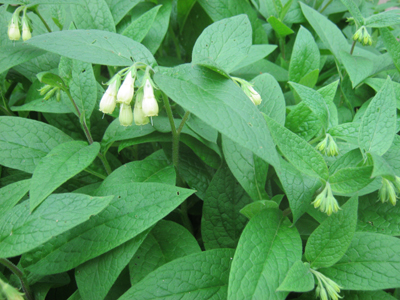
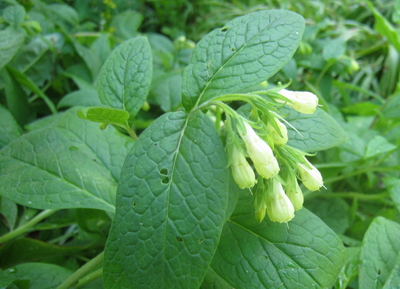
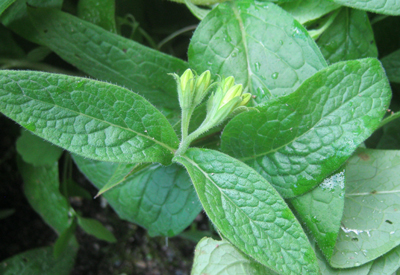
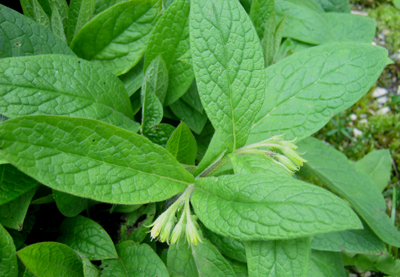
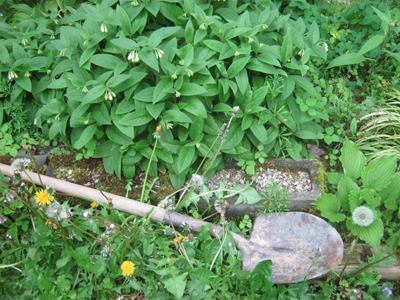
|
Symphytum Tuberosum
"Symphytum
tuberosum L.:
Native of Europe, from Scotland, where it is common in the east, south to
France and Spain, and east to Russia and Turkey. Growing in woods, scrub
and by rivers, flowering in May-June.
Plant creeping to form extensive patches, with a tuberous rhizome. Stems
arching 15-40 cm, little branched. Flowers pale yellow, 15-20 mm long, the
scales not exserted, as they are in S. bulbosum C. Schimper.
Easily grown in shade or a cool position in sun. Early flowering, and dormant
in summer. Hardy to -20 degrees C or less."
-The Random House Book of Perennials, Volume 1: Early Perennials by Roger
Phillips and Martyn Rix, 1991, page 170
“Tuberous Comfrey: Plants form extensive patches, spreading by means
of a creeping tuberous rhizome.
Height x Width: 0.6 x 0.6 metre (1.9 x 1.9 feet).
Light: Semi-shade or full sun, but prefers semi-shade. Prefers moist
soil.
USDA Hardiness Zone: 4 - 8. It is in flower from May to June.
Plants can be grown as a ground cover when planted about 1.2 metres (3.9
feet) apart each way. A good, and sometimes rampant, ground cover plant
for a shady border or woodland.”
-‘Tuberous Comfrey, Symphytum Tuberosum’ by Balkep: The Balkan Ecology Project:
A Permaculture-Inspired, Grassroots Project, www.balkep.org, southeastern
Europe, Bulgaria, 2019.
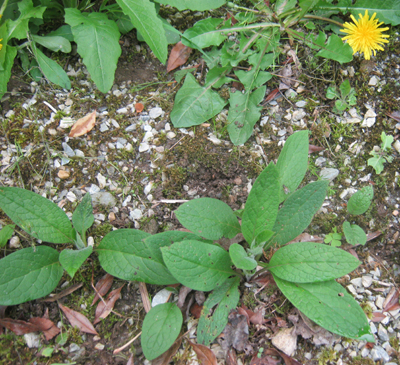
Small tuberous comfrey plants with dandelion.
Tuberous comfrey is sensitive to transplanting and grows slowly. It is one of the smaller species of comfrey.
Tuberous comfrey goes dormant in the middle of the summer. Then starts growing again early autumn. Then goes dormant again in the winter, and starts growing late winter or early spring.
|
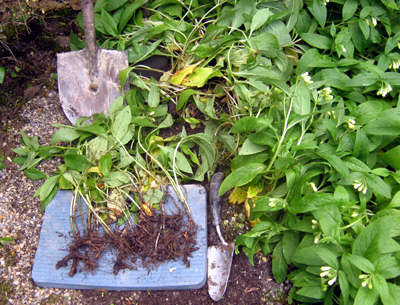
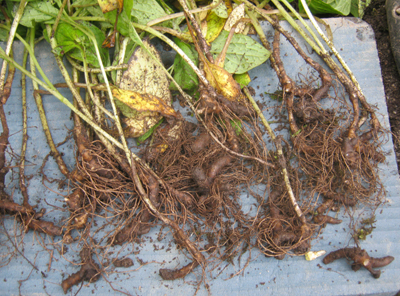
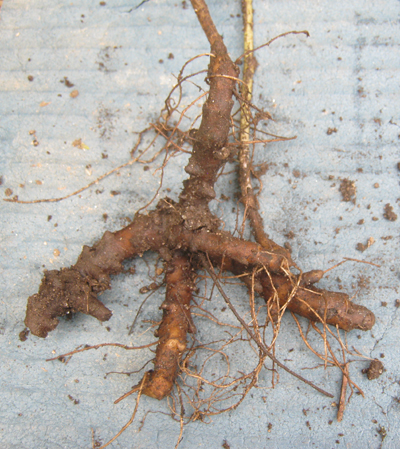
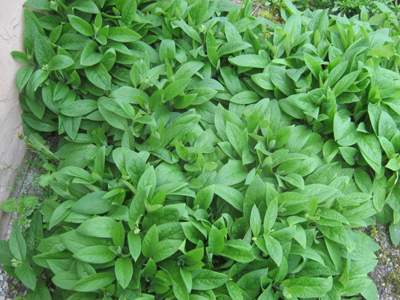
Patch of Tuberous Comfrey in late April
|
Tuberous Comfrey Roots
“Species II.: Symphytum Tuberosum. Linn. Plate MCXVII.
*Reich. Ic. Fl. Germ. et. Helv. Vol. XVIII. Tab. MCCCIV.
**Billot, Fl. Gall. et Germ. Exsicc. No. 2713.
Roots: Rootstock horizontal, tuberous, knotted, fleshy, praemorse, branched, with slender root fibres.
Rootstock fleshy, branching, the divisions somewhat resembling the tubers of the Jerusalem artichoke (but smaller), pale brown.
Stem and Leaves: Stem rather thick, simple or nearly so, very slightly winged above. Leaves all oval or elliptical-oval, the upper ones slightly decurrent, especially the pair at the base of the racemes.
Plant clothed with minute pubescence, intermixed with rather harsh bristly hairs, many of them gland-tipped.
Producing at the apex stems, but no tufts of radical leaves, as in Symphytum officinale.
The stems are 1 to 2 feet (0.3-0.6 meter) high, flexuous, much less winged and less hairy than in Symphytum officinale; the leaves taper towards the base as well as the apex, and are more rugose, much less rough, and with the hairs on the under side of the veins much fewer and shorter.
The plant is of a paler and yellower green, and the lower leaves have turned brown or withered before the flowers expand.
Flowers and Nutlets: Calyx segments strap shaped, divided nearly to the base, in fruit not muricated, the hairs being seated on inconspicuous tubercles. Corolla about twice as long as the calyx; scales included.
The calyx segments are longer, narrower, and less bristly. Corolla about 3/4 inch (1.9 cm) long, ochreous (light brownish-yellow), but rather deeper in colour than in Symphytum officinale.
The mature fruit (nutlets) I have not seen, but, according to ***M.Godron, it is tubercular and contracted above the base.”
-‘English Botany (Sowerby’s); or Coloured Figures of British Plants: Volume 7’ by John T. Boswell and John Edward Sowerby, London, England, 1880, page 116.
(* -‘Icones Florae Germanicae et Helveticae, Volume XVIII’ by Heinrich Gustav Reichenbach, Tab/Plate MCCCIV, 1856-1858. {Reich. Ic. FI. Germ.})
(** -Paul Constant Billot, 1796-1863, was a French botanist born in Rambervillers. With botanist Friedrich Wilhelm Schultz, 1804-1876, he co-authored ‘Archives de la Flore de France et d'Allemagne’. Billot's ‘Annotations a la Flore de France et d'Allemagne’, 1855, was printed with ‘Flora Galliae et Germaniae Exsiccata’ in 1856. It was continued by other botanists as ‘Billotia’.)
|
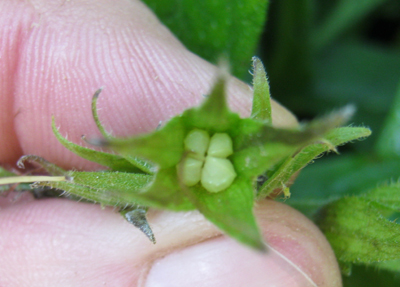
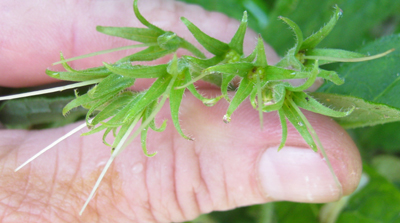
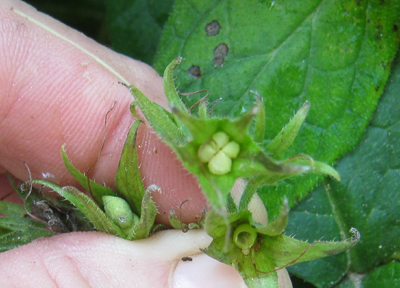
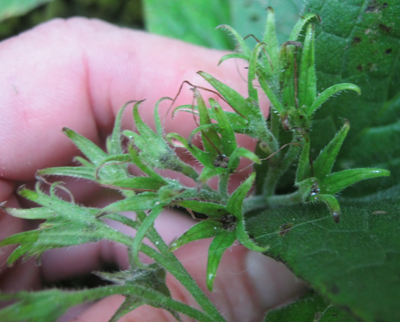
|
Tuberous Comfrey Seeds (Nutlets)
I rarely see
insects pollinating Symphytum tuberosum flowers. I rarely finds seeds in
their flowers so this may be why. They do develop seeds (nutlets) like other
Symphytum if properly pollinated.
They will cross-pollinate with Common
Comfrey and other species of comfrey.
These photos are Tuberous Comfrey flowers after blooms fall off in mid-June.
Photo 1: 4 nutlets (seeds) in flower that will turn dark brown or black
when ripe.
Photo 2: Flowers with tiny nutlets.
Photo 3: One flower with nutlets. One flower with no nutlets. One flower that looks like petals may be covering potential nutlets.
Photo 4: Flowers with no nutlets.
Tuberous Comfrey-- Alkaloids pdf
Low in Alkaloids, High in Allantoin
“S. tuberosum L. has been shown to contain 72 mg/kg PA (Pyrrolizidine Alkaloid) N-oxides in the leaf,
and 180 mg/kg in the root. S. tuberosum contains PA levels significantly lower than other Symphytum
spp. (species) and relatively high levels of allantoin, 0.96% in the root and 0.98% in the leaf.
These findings are only on single samples, but it may become the preferred species for medicinal use.”
-‘Using Herbs that Contain Pyrrolizidine Alkaloids’ by Alison Denham, B.A., MNIMH (National Institute of
Medical Herbalists), University of Central Lancashire, England; The European Journal of Herbal Medicine,
Volume 2, No. 3, pages 27-38, 1996.
|
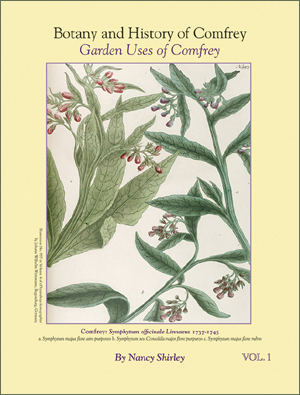
Find out more
about Tuberous Comfrey in
Botany and History of Comfrey; Garden Uses of
Comfrey
Pages 241 to 259.
Tuberosum (Tuberous Comfrey)
Current Botanical Nomenclature
S. tuberosum Subspecies and Varieties
S. angustifolium
S. besseri
S. bulbosum
S. floribundum
S. gussonei
S. leonhardtianum
S. mediterraneum
S. nodosum
S. popovii
S. zeyheri and others
S. tuberosum Distribution (Locations)
Description
S. tuberosum Breeds with Other Symphytum Species
Chromosomes
Alkaloids
|
Symphytum
Tuberosum Complex:
Subspecies and Varieties
"The
Symphytum tuberosum complex belongs to one of the most complicated groups
within the genus Symphytum Linnaeus (1753: 136) in Europe, mainly due to
an occurrence of polyploidy and associated extensive morphological variability
(Gadella & Kliphuis 1978, Murín & Majovsky 1982, Kobrlova et al. 2016).
Despite current progress, the taxonomy of S. tuberosum is still not satisfactorily resolved. The members of this complex are distributed across Europe and Asia Minor (Bucknall 1913, Murin & Majovsky 1982, Kobrlova et al. 2016) and a total of ten taxa have been described within this complex, three of them from Central Europe:
Symphytum tuberosum Linnaeus (*1753: 136)
Symphytum angustifolium A.Kerner (**1863: 227)
Symphytum leonhardtianum Pugsley (***1931: 95)."
-‘Taxonomic Status and Typification of a Neglected Name Symphytum Leonhardtianum from the Symphytum Tuberosum Complex (Boraginaceae)” by Lucie Kobrlova, Terezie Mandakova and Michal Hrones (all from Czech Republic); Phytotaxa, Volume 349, No. 3, pages 225-236, 2018.
(* -‘Species Plantarum’ by Linnaeus, Volume 1, Symphytum tuberosum page 136.)
(** -‘Descriptiones Plantarum Novarum Florae Hungaricae et Transsilvanicae’ by A. Kerner, Oesterreichische Botanische Zeitschrift {Austrian Botanical Journal}, Vienna, Austria, Volume 13, No. 7, page 227, 1863.)
(*** -‘The Forms of Symphytum Tuberosum L.’ by H.W. Pugsley, B.A., F.L.S., Journal of Botany: British and Foreign, London, England, Volume 69, page 95, April 1931.)
|
|














